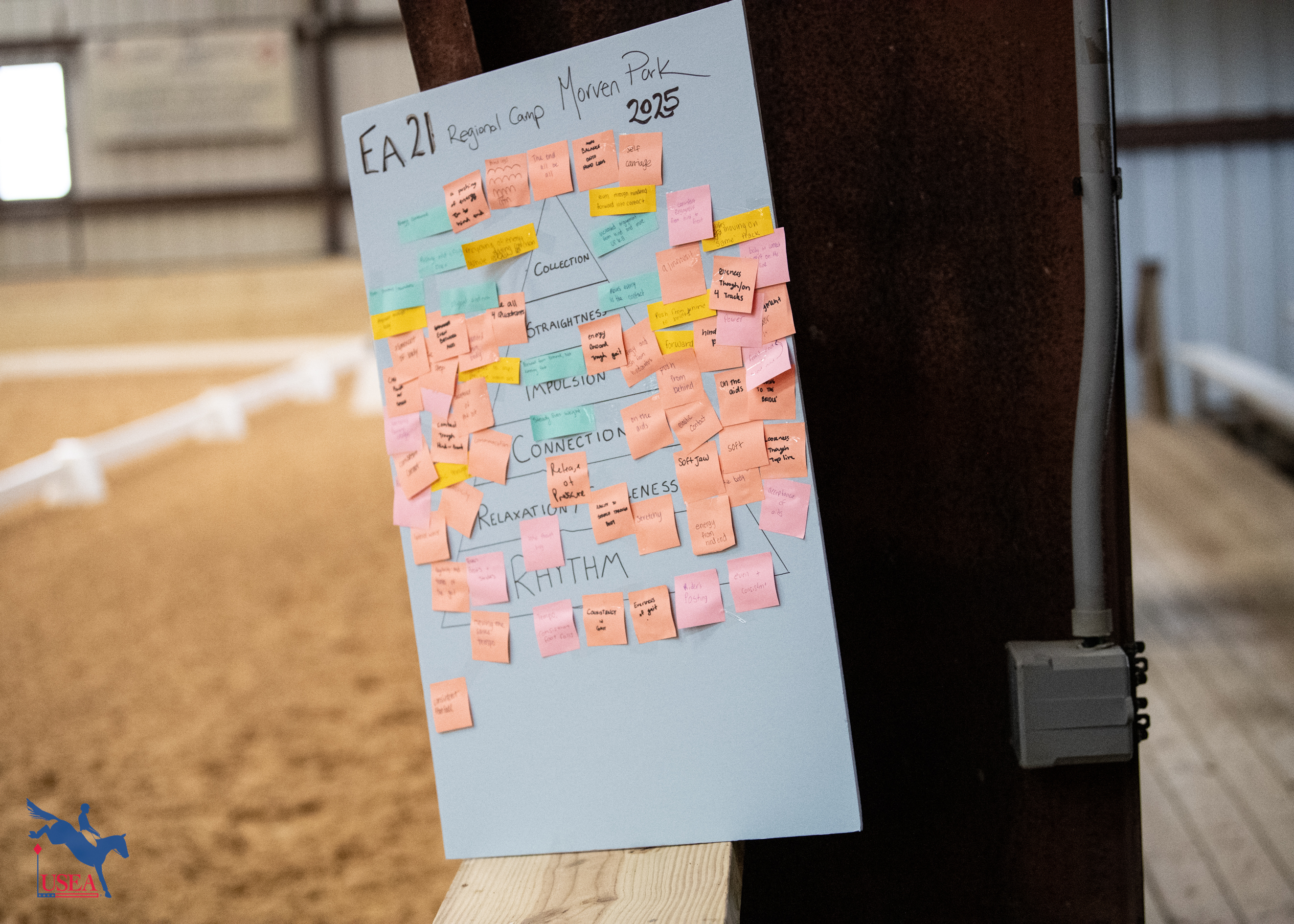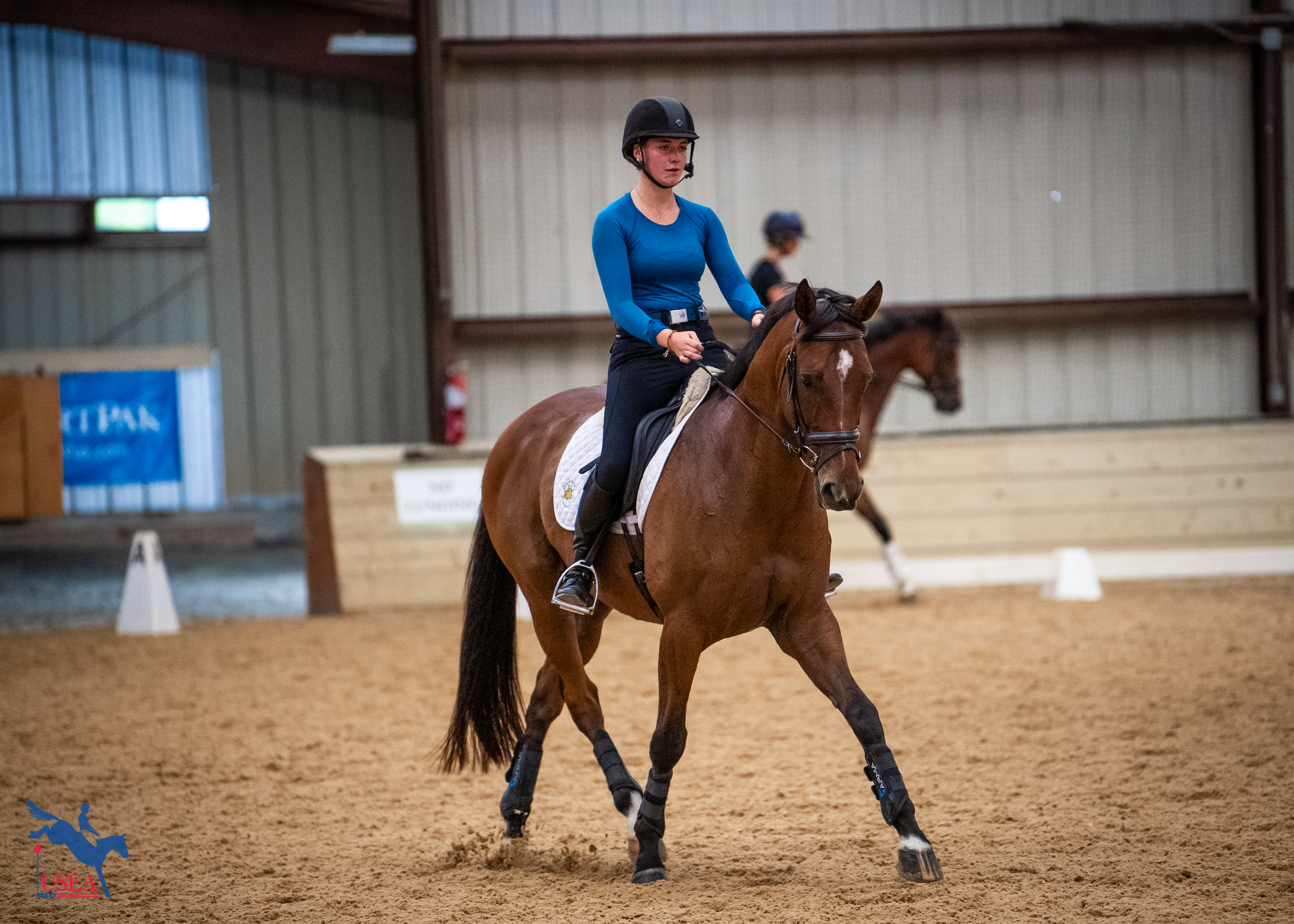Working on Engagement and Suppleness on Day 1 of the USEA EA21 East I Clinic

Leesburg, Va.—June 17—Twelve talented riders got a chance to ride with five-star rider Bec Braitling at the Morven Park International Equestrian Center today, the first day of the USEA’s Eventing Athletes Under 21 (EA21) East I clinic.
The focus was on dressage, with exercises that helped every horse from Training level and above as they prepare for jumping lessons tomorrow.
Yesterday, Braitling reviewed the German Training Scale with the riders in a classroom session, and today they put that scale to work, utilizing the basic tenants of rhythm, relaxation, connection, impulsion, straightness, and collection as they worked through a series of exercises in pairs.
Adding to the challenge, each set of riders switched horses partway through their lesson, then hopped back on their own horse. At the end of each session, Braitling asked them to explain what they felt was different or improved.
The concept was introduced last year, and Braitling had no qualms about the riders being capable to switch horses as many have the opportunity to ride multiple horses in their day-to-day lives.

“It’s always really interesting because either somebody gets a lot out of the switch ride horse, and they get to practice something on the switch ride horse that they couldn't necessarily practice on theirs at the level, or they would get back on their horse and be like, ‘Oh, I really like that. I want to take that to my horse,’ so I thought that was a kind of a fun thing,” she said. “You could sit there and say, ‘Hey, do this, do this, do this,’ but then when you got on the other horse, it was just like, you had to do it. It kind of brought that out in the riding—and it was really fun watching everyone get back on their horses.”
Although she didn’t plan it, Braitling was pleasantly surprised that some of her six groups ended up with a Thoroughbred and a purpose-bred warmblood pairing, adding to the challenge of riding through the exercises she presented and switching horses.
“You've got the strengths and weaknesses of each type, right?” she said. “So, then each one could bring something to the other’s riding. [You need to] really focus on that or identify that's a weakness on this horse. It's not like you're changing what you're doing in regard to the training scale; you're just using it to say, ‘Yeah, the rhythm is really good. I’ve got really good relaxation, but I still have a connection problem. So, do I need to be thinking, where is my impulsion? What am I lacking here?’ I've kind of made everybody think a little more critically about those things.”
One example she gave to a rider on a nervous Thoroughbred was to ride green Thoroughbreds like they know what they’re doing so they have the comfort of their rider’s aids and have a leader straightaway. Widening the hands a bit on circles and in lateral exercises helps show them how to use their body.

Braitling used two major exercises for all the groups. The first was having riders use a 10-meter circle in the corner, followed by a lengthened or medium trot on the diagonal, then back to a 10-meter circle in the corner.
She likes this exercise because it teaches the horse and rider about creating engagement while making sure the rider is riding the horse from back to front. The circle naturally shortens the horse and helps create suppleness through the body—then you test the horse by riding across the diagonal in a lengthened trot and encourage it to use its hocks. It can be done in trot or canter. Elasticizing the horse in this way will be helpful come tomorrow for jumping coursework where the ability to change the canter is key.
“The biggest thing when you’re thinking compression exercises—don’t strangle the horse,” said Braitling. “Don’t shorten the neck and lose the hind leg. Circles are a good natural way to let the horse feel the balance themselves. Now, how do I get that feeling at the end of a long side when I come out of a lengthened canter?”

The second exercise was leg yielding from the rail in trot and canter, which helped with lateral suppleness.
“I liked it more in the canter,” she said. “We worked on changing the bend on the horses that looked like they needed a little more suppling. Some of the upper-level horses, it was fun because they just wanted to go into a half pass, so we were challenging them a little bit more elastically that way. So, we'd worked a little bit on lengthening and compressing, and then now we're sort of working on the sideways suppleness. And again, always trying to keep going back to creating engagement. And what are we going to do with that once we've got it? That's why, at the end, I'd always like them to trot and just show me the trot a little bit to see that it was better because of what we did.”
Braitling is excited to see how the dressage work will translate to the jumping tomorrow. She plans to set up some gymnastic exercises, do some coursework, and set up a few exercises that will simulate cross-country questions.
“We got some pretty good understanding of direction,” she said. “I think everyone was pretty strong. Understanding just always riding back to front and then thinking about how we're going to take that feeling, say, out of a 10-meter circle. How does that feel then going into a turn to a fence? How does that correlate to jumping? Because we're using those same ideas going into turns. We're using the same idea of straightness. We're establishing straightness and then being able to lengthen and compress and move seamlessly through that. It’s just laying that foundation.”
Riders will have an early start tomorrow at 7:30 a.m. for group jumping lessons.
East I | Morven Park Equestrian Center | Leesburg, Virginia
The Participants:
- Olivia Cannizzaro
- Addison Hagan
- Madison Haney
- Carlin Keefe
- Audrey Littlefield
- Katherine Maroko
- Caitlin O’Roark
- Chloe Paddack
- Eliza Quigley
- Ella Spiers
- Annabelle Sprague
- Riley Zgrebnak
Don't forget to follow the USEA’s coverage on social media!
Facebook | Instagram | Threads
About the USEA Emerging Athlete U21 Program (EA21)
The purpose of the USEA Emerging Athletes U21 Program (EA21) is to identify and provide consistent quality instruction to the next generation of elite event riders. The aim is to create a pipeline for potential team riders by identifying and developing young talent, improving horsemanship and riding skills, and training and improving skills and consistency.
The USEA Emerging Athletes U21 Program was launched in 2022 with a model of five summertime regional clinics taught by carefully selected USEA Eventing Coaches Program (ECP) coaches, leading to a winter national camp consisting of selected Young Riders from the regional clinics. Athletes who are 21 years or younger, are current members of their USEA Young Rider Area program, and are established at the Training Level or higher, are eligible to apply for the EA21 program. Click here to learn more about the USEA EA21 Program.
The USEA would like to thank ARMA, Bates Saddles, Horse Illustrated, Kerrits, PulseVet, Ride iQ, Schneiders Saddlery, Sidelines Magazine, WeRideTogether, and YETI for sponsoring the USEA Emerging Athletes U21 Program.






























